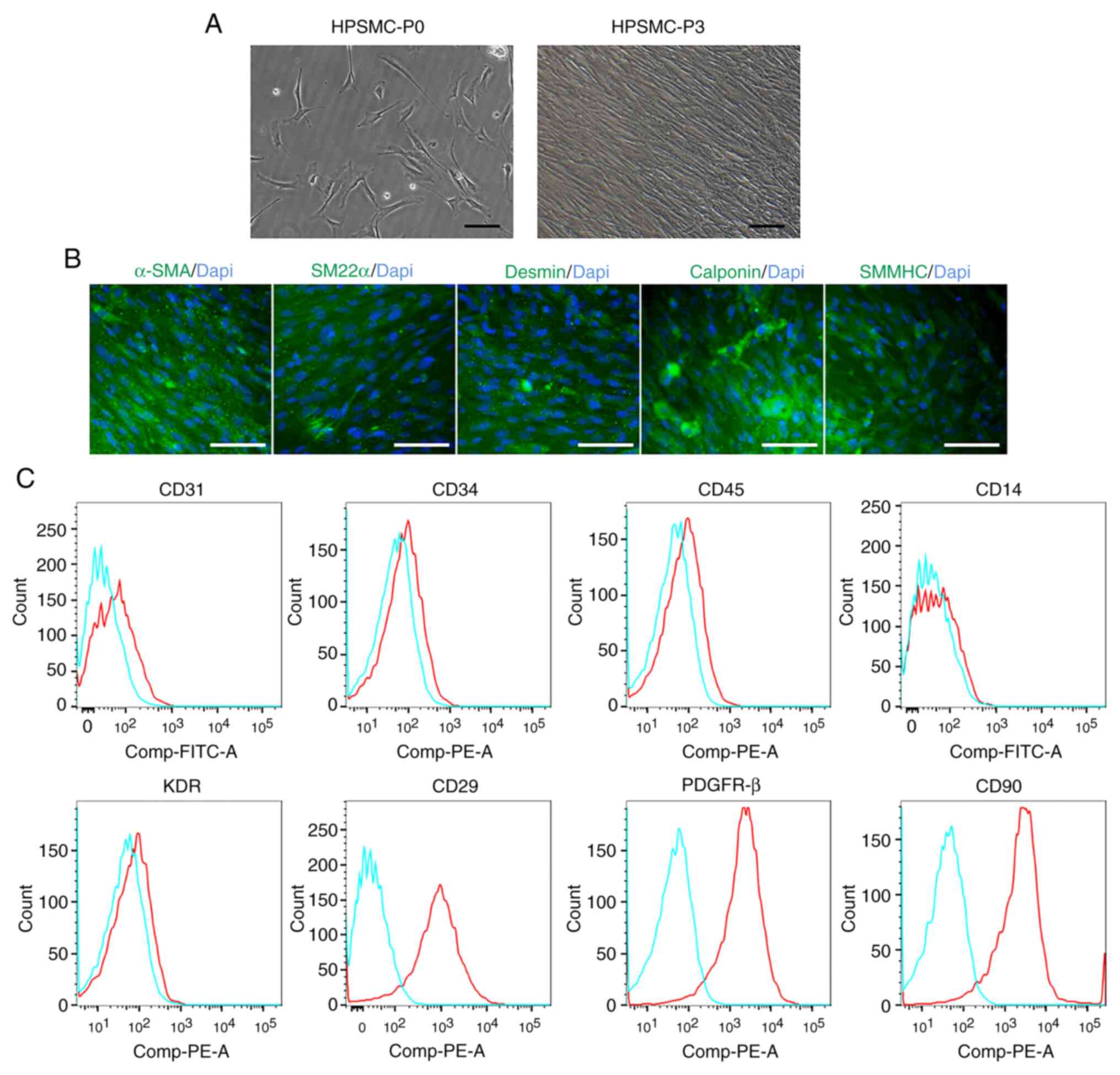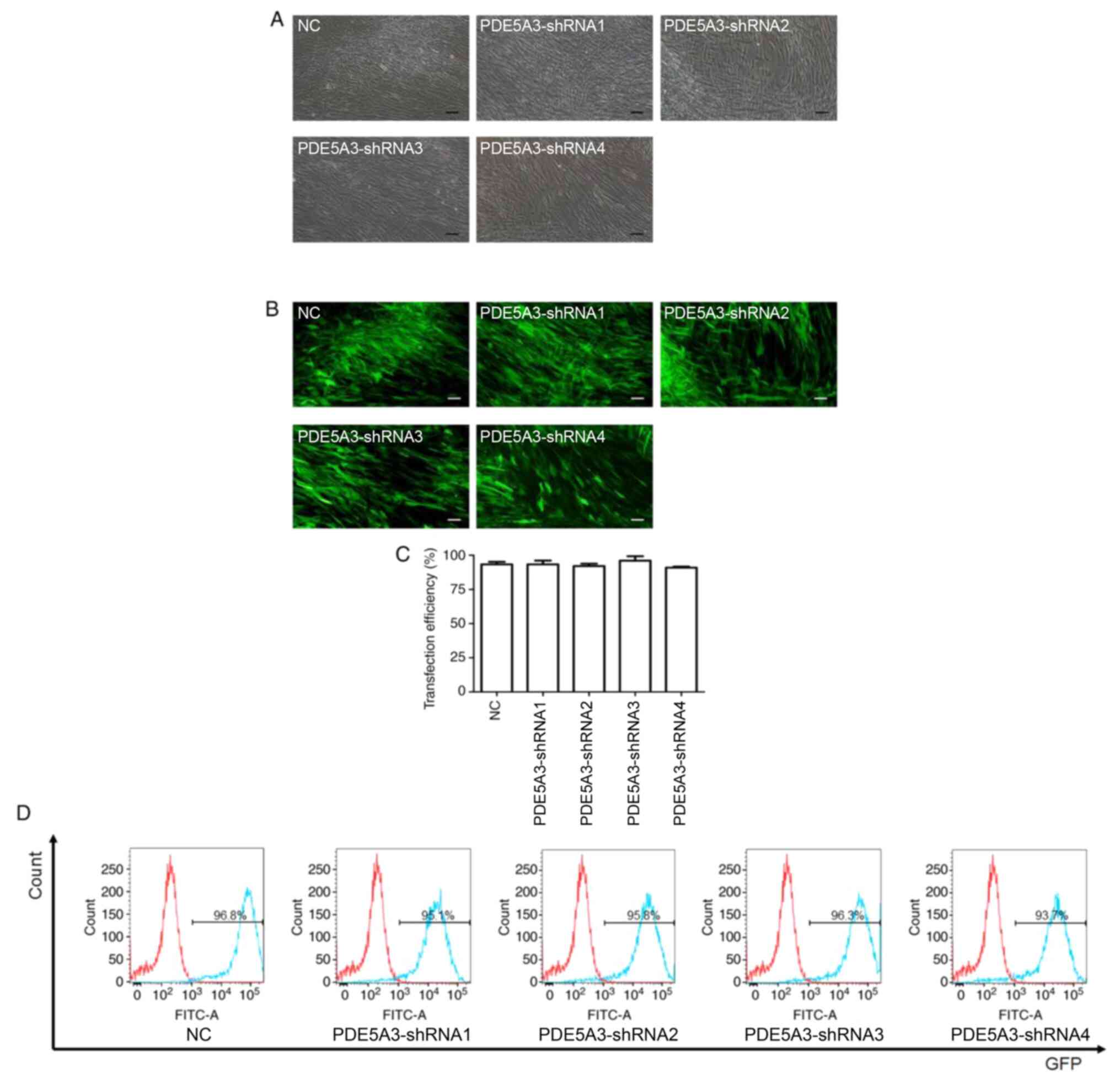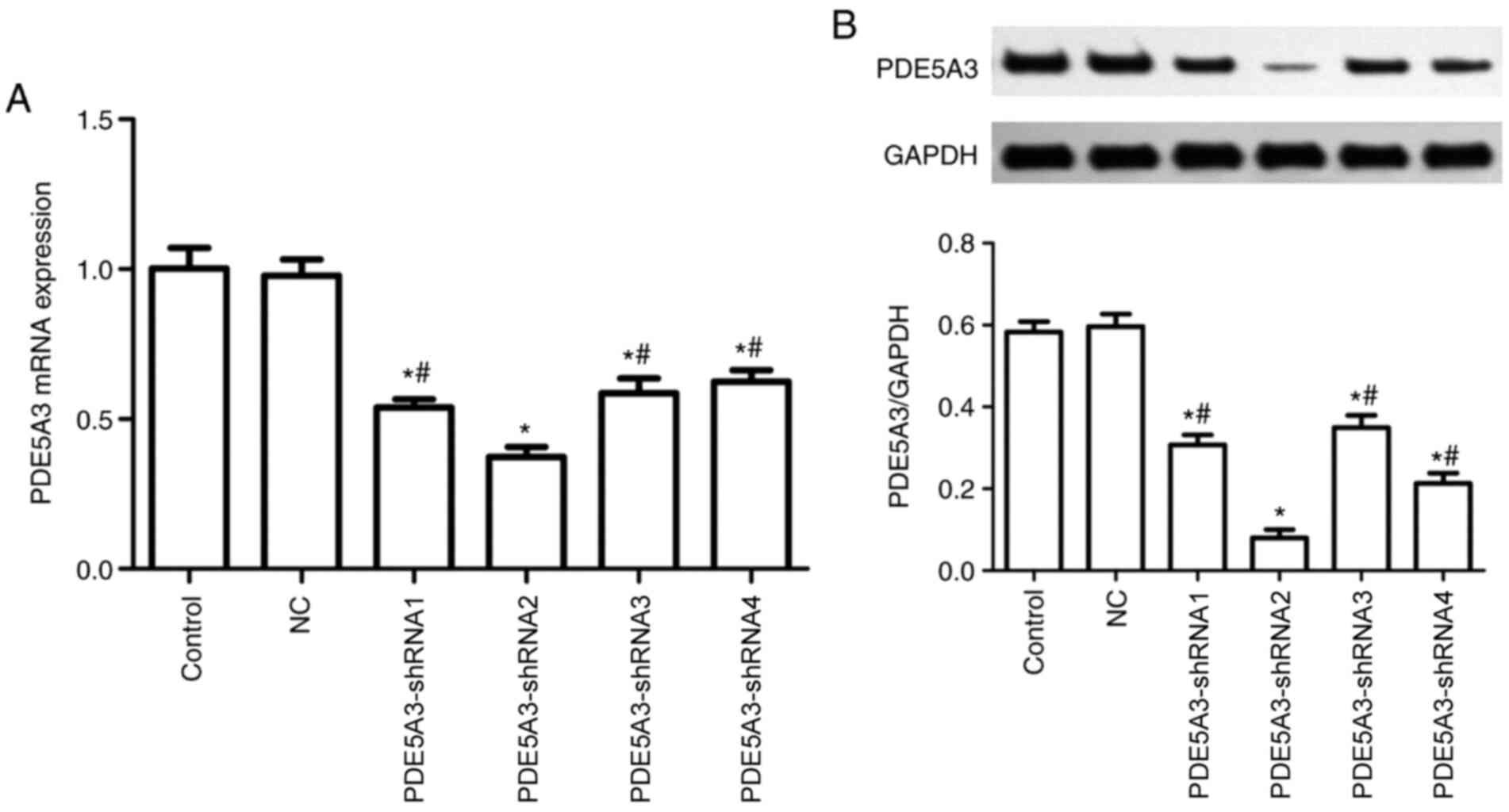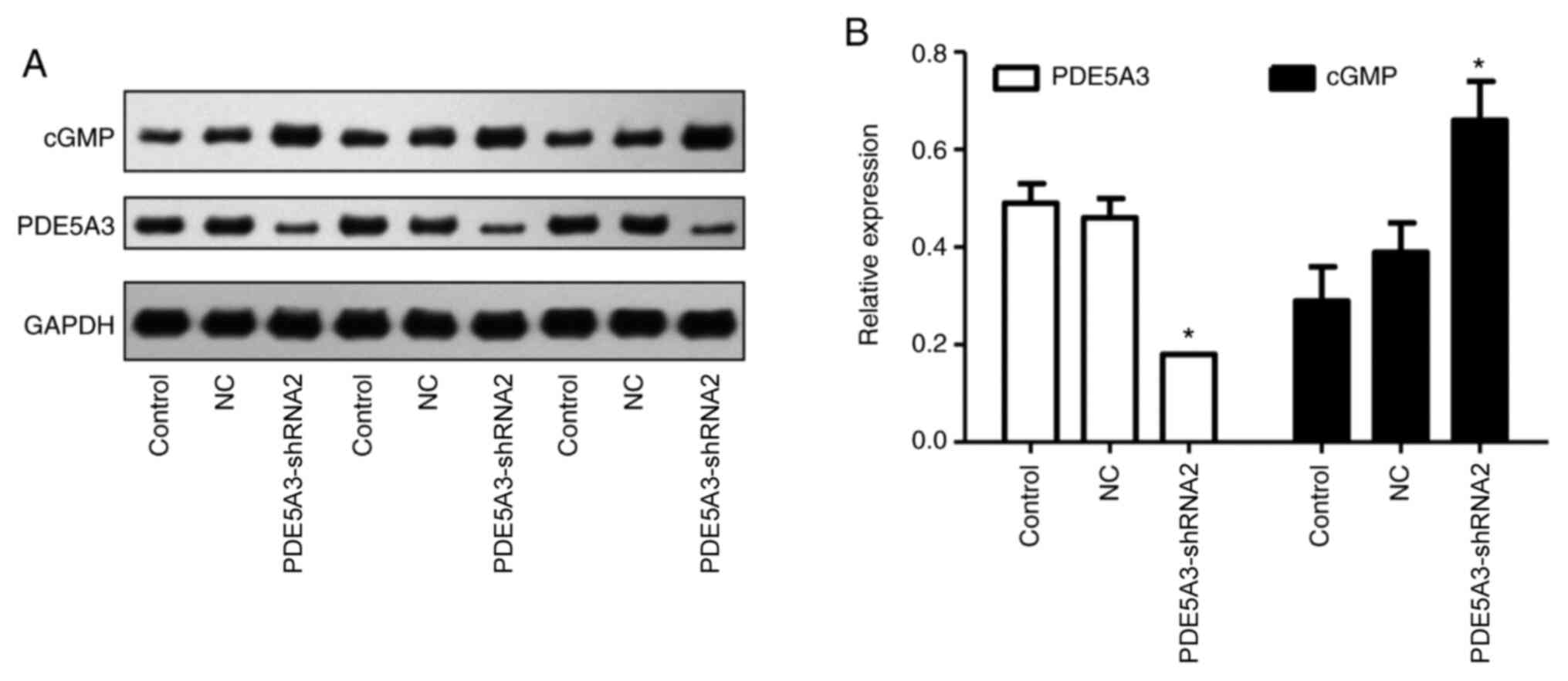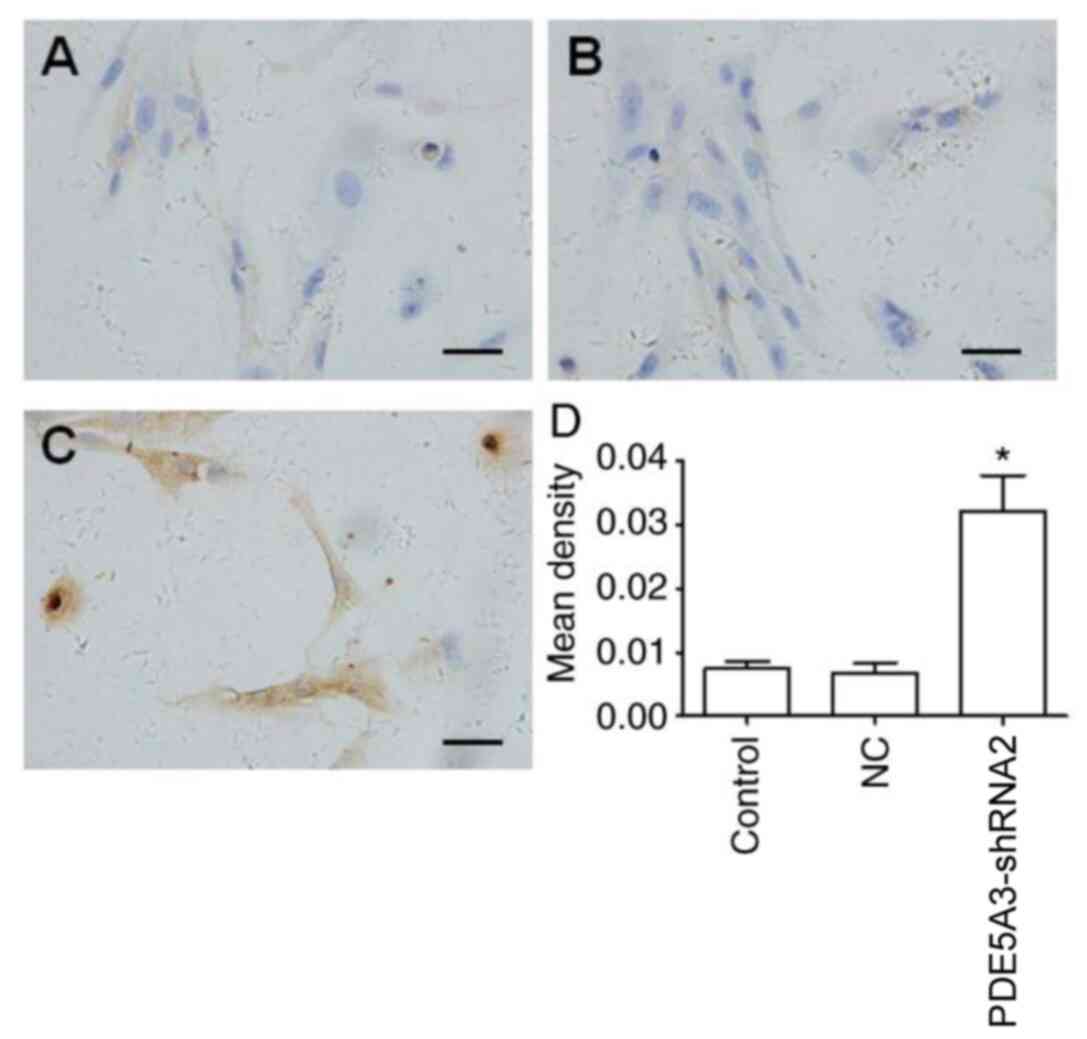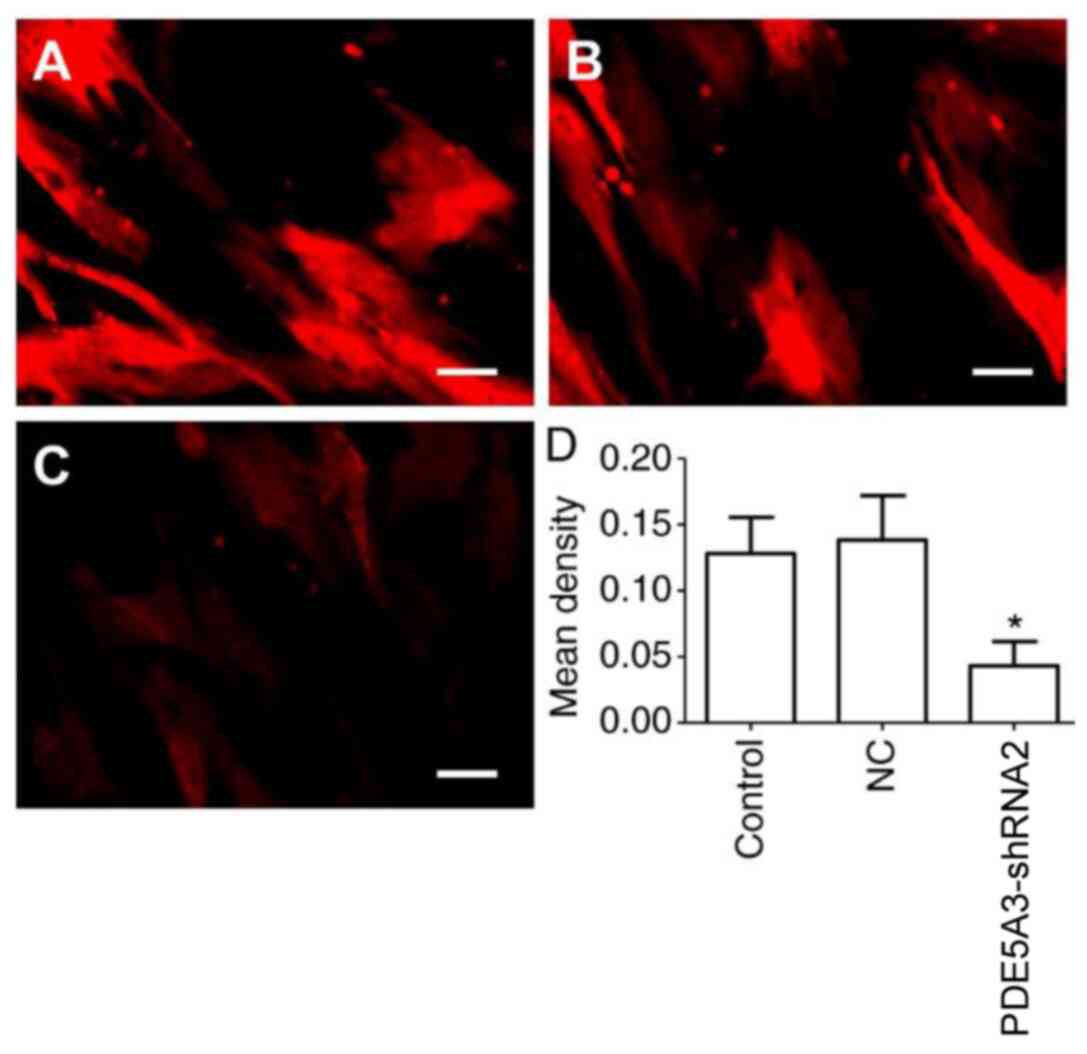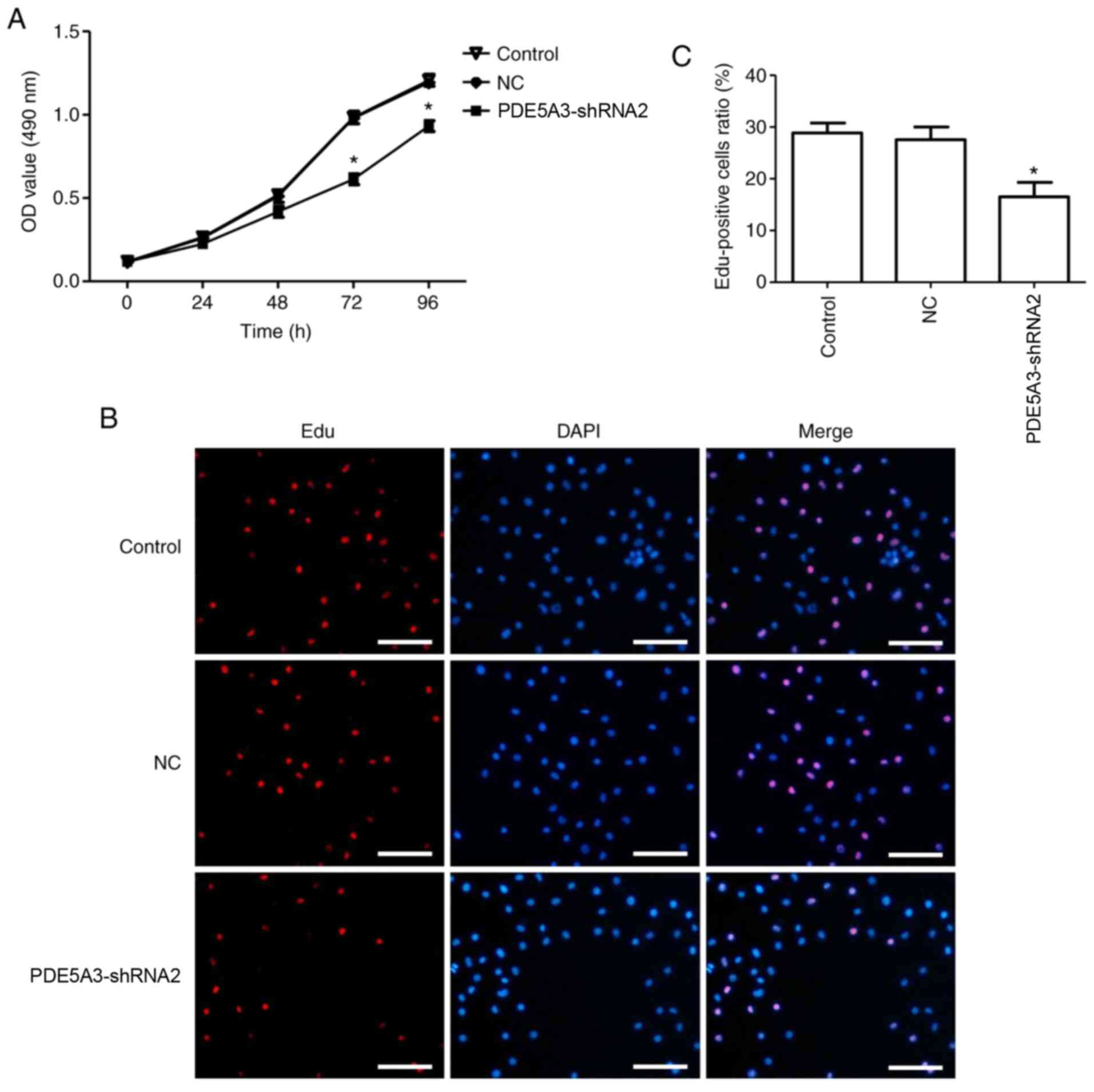Effects of shRNA‑mediated silencing of PDE5A3 on intracellular cGMP and free Ca2+ levels and human prostate smooth muscle cell proliferation from benign prostatic hyperplasia
- Authors:
- Published online on: February 5, 2021 https://doi.org/10.3892/etm.2021.9753
- Article Number: 322
-
Copyright: © Xu et al. This is an open access article distributed under the terms of Creative Commons Attribution License.
Abstract
Introduction
Benign prostatic hyperplasia (BPH) is an irregular benign hyperplasia of smooth muscle cells and other stromal cells in the transitional area of the prostate gland (1,2). BPH may be induced by a variety of risk factors, including obesity, hyperlipidemia, type 2 diabetes and certain androgenic hormone disorders, which may lead to a series of lower urinary tract symptoms (LUTS) (3,4). BPH with LUTS is a common disease that is associated with androgen among older men (4). According to statistical data in the USA, the incidence of BPH in men aged >50 years is ~50%, where the incidence in men aged >80 years can reach as high as 80% (5). Accumulating evidence suggest that BPH/LUTS is also closely associated with the occurrence of erectile dysfunction (ED), where severe bladder outlet obstruction may induce sexual dysfunction (6-8). Since BPH/LUTS can significantly reduce the life quality of older men (5,6,9), a safe and effective therapeutic strategy for this condition is warranted.
Phosphodiesterases (PDEs) by regulate the intracellular concentrations of cyclic nucleotides by catalyzing the hydrolysis of both cyclic adenosine monophosphate (cAMP) and cyclic guanosine monophosphate (cGMP) (10). The PDE superfamily consists of 11 gene families (PDE1-11), each presenting distinct affinities for cAMP and cGMP (11). Among them, phosphodiesterase 5 (PDE5) is a specific cGMP hydrolase, such that the inhibition of PDE5 activity can block cGMP hydrolysis and reduce intracellular Ca2+ concentration to promote smooth muscle relaxation (12). This suggests that PDE5 may serve as a potentially promising target for the treatment of BPH/LUTS (13,14). However, since PDE5 is ubiquitously expressed in the human body and participates in a number of physiological and pathological processes in numerous tissues or organs, inhibition of PDE5 using traditional inhibitors may induce various adverse side effects (15,16). Therefore, an effective inhibitor targeting PDE5 that causes fewer adverse side effects is required.
PDE5 can be divided into three subtypes based on the different terminal sequences, namely PDE5A1, PDE5A2 and PDE5A3(17). In particular, PDE5A3 is mainly found in human smooth muscle tissues but is absent in a number of essential organs and tissues, including the brain, lung, liver, kidney and skeletal muscle (15). Short-hairpin RNA (shRNA) is a versatile tool that has the potential to modulate cell gene expression in a stable manner (18). Pan et al (19) previously revealed the effects of shRNA-mediated downregulation of PDE5A3 on cGMP in smooth muscle cells of human corpus cavernosum. However, this study of PDE5A3 was mainly performed on the penis, whilst the role of PDE5A3 in human prostate smooth muscle cells and patients with BPH/LUTS remain poorly understood.
The aim of the present study was to effectively silence the expression of the PDE5A3 gene stably by shRNA transfection and observe its effects on the intracellular levels of cGMP and free Ca2+ in human prostate smooth muscle cells (HPSMCs), with specific focus on HPSMC proliferation. The purpose of the present study was to identify a potential target for the treatment of BPH/LUTS.
Materials and methods
Tissue collection and cell culture
Prostate tissues from six male patients with BPH (67.3±8.4 years old) who underwent transurethral resection of the prostate were initially collected. Surgery was performed at the Department of Urology, Nanjing First Hospital, Nanjing Medical University (Nanjing, China). The present study was approved by the Ethics Committee of Nanjing Medical University and written informed consents were collected from all participants. The BPH tissues were placed in sterile tubes containing PBS before being immediately transported on ice to the laboratory. After being briefly washing three times using fresh sterile PBS, BPH tissues were sliced into small pieces and digested using collagenase (type I, 0.075%; Sigma-Aldrich; Merck KGaA) at 37˚C on an orbital shaker. After 30 min enzymatic digesting, the cell suspension was strained using a 75-µm mesh (Corning, Inc.) and subsequently centrifuged at 400 x g for 5 min at room temperature (RT). The cell pellet was then resuspended in fresh DMEM containing 10% FBS and centrifuged once more (400 x g for 5 min at RT) to remove any residual collagenase and thereafter cultured on new dishes. Cells in all dishes were cultured at 37˚C in an incubator with 5% CO2 and 95%air (20). After continuous culture to passage 3 and differential velocity adherent (smooth muscle cells require longer adherence time compared with fibroblasts), the stromal cells (except smooth muscle cells) were gradually removed and homogeneous HPSMCs were finally obtained. Cellular assays were performed in 24-well plates or 96-well microplates (Corning, Inc.) with an initial seeding density of 1x104 cells per well or 2,000 cells per well, respectively.
Cell identification
Freshly isolated HPSMCs at passage 3 were gathered, washed three times with PBS containing 1% bovine serum albumin (BSA; Beijing Solarbio Science & Technology Co., Ltd.) and centrifuged at 400 x g for 5 min at RT. Subsequently, cells were fixed at RT in 4% buffered paraformaldehyde for 20 min before 0.1% Triton X-100 was utilized to permeabilize the cell membranes for 10 min at RT. After rinsing twice, blocking solution (1% BSA in PBS) was applied for 30 min at RT and the cells were subsequently incubated with primary antibodies against α-smooth muscle actin (α-SMA; cat. no. ab32575; 1:100; Abcam), trasngelin-1 (SM22α; cat. no. ab212857, 1:200; Abcam), Desmin (cat. no. ab271829; 1:100; Abcam), Calponin (cat. no. MABT1504; 1:300; Sigma-Aldrich; Merck KGaA) and smooth muscle myosin heavy chain (SMMHC; cat. no. ab133567; 1:100; Abcam) at 4˚C overnight. The cells were then washed three times with PBS and incubated with FITC-conjugated secondary antibodies (cat. nos. ab7086 and ab7064, 1:300; Abcam) at RT for 1 h. Thereafter, the cells were incubated with DAPI (5 mg/ml, Beyotime Institute of Biotechnology) at RT for 10 min and rinsed three times with PBS. Fluorescent signals were detected at x200 magnification using a Nikon A1R confocal microscope (Nikon Corporation) with the NIS-Elements AR 4.0 software package (Nikon Corporation).
In addition to immunofluorescence staining, collected and washed HPSMCs (1x106/100 µl) were also incubated with conjugated primary antibodies against CD31 (FITC; cat. no. 557508; 1:200; BD Biosciences), CD34 (phycoerythrin (PE); cat. no. NBP2-34713PE, 1:200; Novus Biologicals, LLC), CD45 (PE; cat. no. 560975; 1:200; BD Biosciences), CD14 (FITC; cat. no. 561712, 1:200; BD Biosciences), kinase insert domain receptor (KDR; PE; cat. no. FAB357P; 1:200; R&D Systems, Inc.), CD29 (PE; cat. no. 557332, 1:200; BD Biosciences), platelet-derived growth factor receptor β (PDGFR-β; PE; cat. no. 558429, 1:200; BD Biosciences) and CD90 (PE; cat. no. 561970, 1:200; BD Biosciences) at RT for 40 min in the dark. After washing twice, the collected cells were resuspended in PBS and further investigated using a BD FACSCalibur™ flow cytometer (BD Biosciences). All flow cytometry data were analyzed using FlowJo (version 10.0.7; FlowJo LLC). IgG-matched isotypes (PE; Mouse IgG, cat. no. 555749, 1:200; cat. no. 554679, FITC-Mouse IgG 1:200; BD Biosciences) were utilized for each procedure.
shRNA transfection
According to the design principles for the RNA interference target sites, PDE5A3 shRNA sequences were designed based on the PDE5A3 sequence (GenBank accession number: NM_033437; https://www.ncbi.nlm.nih.gov/nuccore/NM_033437.4), where four of which were eventually selected. The corresponding sequences are shown in Table I. The target non-homologous shRNA was also selected as a negative control. The shRNA lentiviral particles were constructed as previously described (21). Lentiviruses were generated by transfecting 293T cells with 1.5 µg shRNA-encoding plasmids (pGLV3/H1/GFP + Puro; Shanghai Jikai Gene Chemical Technology Co., Ltd.). For transduction, the HPSMCs were passaged to 60% confluence in a 24-well plate before Opti-MEM medium (0.5 ml per well; Gibco; Thermo Fisher Scientific, Inc.) with 5 µg/ml polybrene (Sigma-Aldrich; Merck KGaA) was added to the cells. Subsequently, the viral particles were added at a multiplicity of infection of 10. After 24 h incubation in 5% CO2 at 37˚C, the viral particle-containing medium was removed and fresh DMEM with 10% FBS was added for further incubation. After 2 days, cells were screened using 3 µg/ml puromycin (Sigma-Aldrich; Merck KGaA) for 4 days at 37˚C. Cells were then assigned to the control group (no transfection), NC group (transfected with NC shRNA), shPDE5A3-1 group (transfected with PDE5A3-shRNA1), shPDE5A3-2 group (transfected with PDE5A3-shRNA2), shPDE5A3-3 group (transfected with PDE5A3-shRNA3) and shPDE5A3-4 group (transfected with PDE5A3-shRNA4). Transfection efficiency was monitored using flow cytometric analysis and fluorescence microscopy, which was verified further by reverse transcription-quantitative PCR (RT-qPCR) and western blot analysis. For flow cytometric analysis, the transfected cells were gathered, washed three times with PBS containing 1% BSA, centrifuged at 400 x g for 5 min at RT and investigated further using a BD FACSCalibur™ flow cytometer (BD Biosciences) using the FITC channel. All flow cytometry data were analyzed using Flow Jo (version 10.0.7; FlowJo LLC). For fluorescence detection, the transfected cells were washed twice using PBS and observed using fluorescence microscopy at x100 magnification. The transfection efficiency was decided by the proportion of GFP-positive cells.
RT-qPCR
The extraction of total RNA in cells was carried out using the TRIzol™ Plus RNA purification kit (cat. no. 12183555; Invitrogen; Thermo Fisher Scientific, Inc.) on the basis of manufacturer's protocol. The purified RNA was then reverse transcribed to cDNA using High-Capacity cDNA Reverse Transcription kit (cat. no. 4368814; Applied Biosystems,; Thermo Fisher Scientific, Inc.). To perform reverse transcription, the conditions were set as following: 25˚C for 10 min, 37˚C for 120 min and 85˚C for 5 min. LightCycler 480 System (Roche Applied Science) was utilized to carry out the RT-qPCR experiments. According to the specifications, the qPCR reaction mixture volume was 20 µl and included 10 µl 2X SYBR™ Green PCR Master Mix (cat. no. 4309155; Applied Biosystems; Thermo Fisher Scientific, Inc.), 1 µl cDNA template, 1 µl forward primer (10 µM), 1 µl reverse primer (10 µM) and 7 µl sterile water. The qPCR conditions were set as following: 95˚C for 10 min, followed by 40 cycles at 95˚C for 20 sec and 60˚C for 1 min. Relative expression of PDE5A3 mRNA was expressed as 2-ΔΔCq (22). GAPDH was utilized as the control for normalization. The specific primer sequences of PDE5A3 and GAPDH are shown in Table II.
Western blotting
Total proteins were extracted from HPSMCs in each treatment groups using a Total Protein Extraction Kit (cat. no. KGP2100; Nanjing KeyGen Biotech Co., Ltd.). Protein concentration was quantified using a bicinchoninic acid protein assay kit (Nanjing KeyGen Biotech Co., Ltd.). SDS-PAGE and immunoblotting were performed according to the manufacturer's protocols (Bio-Rad Laboratories, Inc.). Briefly, polyvinylidene fluoride membranes (EMD Millipore) were blocked using 5% skim milk dissolved in TBS (pH 7.5)-0.1% Tween-20 (TBS-T) for 2 h at RT after protein transfer from 12% SDS-PAGE gels (50 mg/lane). Subsequently, the membranes were incubated overnight at 4˚C with either the rabbit polyclonal anti-PDE5A3 antibody (cat. no. ab64179; 1:1,000; Abcam) or rabbit polyclonal anti-cGMP antibody (cat. no. ab12416; 1:2,000; Abcam). The membranes were then washed with TBS-T and incubated with horseradish peroxidase (HRP)-conjugated anti-rabbit secondary antibody (1:5,000; cat. no. KGAA35; Nanjing KeyGen Biotech Co., Ltd.) at RT for 2 h. Enhanced Chemiluminescence Detection Kit (Bio-Rad Laboratories, Inc.) and the ImageJ software (version 1.5i; National Institutes of Health) were used to detect and semi-quantitatively analyze the immunoreactive proteins. This experiment was performed three times.
Immunocytochemical staining
The pretreatment process was identical to that of immunofluorescence staining aforementioned. After and blocking, HPSMCs were incubated with the rabbit anti-cGMP antibody (cat. no. ab12416; 1:100; Abcam) at 4˚C overnight. On the following day, each sample was washed three times with PBS for 5 min each time, before incubation with HRP labeled goat anti-rabbit II (cat. no. KGAA35; 1:500; Nanjing KeyGen Biotech Co., Ltd.) for 30 min at RT. Diaminobenzidine (DAB; cat. no. KGP1045; 1:10; Nanjing KeyGen Biotech Co., Ltd.) was used for 5 min at RT for coloring, and nuclear counterstain was performed in hematoxylin (Beijing Solarbio Science & Technology Co., Ltd., H8070) for 3 min at RT. All samples were detected by light microscopy at x200 magnification after re-staining. The level of cGMP was assessed using the Image Pro Plus software (version 6.0.0.260; Media Cybernetics, Inc.). The mean density=total density/cell area.
Intracellular free Ca2+ assay
The level of intracellular free Ca2+ in HPSMCs was determined at 48 h after 4 days puromycin screening using rhod2-AM (cat. no. R1244; Invitrogen; Thermo Fisher Scientific, Inc.). In order to remove extracellular Ca2+ and detect only intracellular free Ca2+, the cultured cells were washed with sterile PBS along with a chelator solution (10 mM glucose, 10 mM EGTA, 110 mM NaCl, 10 mM HEPES, pH 7.4). The HPSMCs were then incubated with rhod2-AM (4 µM) in serum-free DMEM at 37˚C for 30 min. After rinsing the HPSMCs three times using serum-free DMEM, the signal of intracellular free Ca2+ was detected using fluorescence microscopy at x200 magnification and assessed further using the Image-Pro Plus software (version 6.0.0.260; Media Cybernetics, Inc.). The mean density=total fluorescence density/cell area.
MTT assay
HPSMCs in logarithmic phase were collected before 3,000 cells from each group were inoculated into three duplicated wells. After cell incubation for 24, 48, 72 and 96 h at 37˚C, 5 mg/ml MTT (20 µl) solution (Beyotime Institute of Biotechnology) was added to each well at the corresponding time points, followed by incubation at 37˚C for 3 h. Thereafter, the culture medium and MTT in each well were removed and 150 µl DMSO (Beyotime Institute of Biotechnology) was added into each well before the plates were continuously shaken for 10 min. The optical density value at 570 nm in each well was detected using a microplate reader.
Assessment of cell proliferation by EdU assay
The proliferation of HPSMCs were also detected using BeyoClick™ EdU-555 kit (cat. no. C0075; Beyotime Institute of Biotechnology) according to the manufacturer's protocols. HPSMCs were seeded in 96-well plates at 1,000 cells per well. After 72 h of seeding, HPSMCs were incubated with EdU (10 µM) for 2 h at 37˚C. After fixation with 4% paraformaldehyde at RT for 10 min, cell nuclei were stained with DAPI (5 mg/ml; Beyotime Institute of Biotechnology) for 15 min at RT. EdU-positive cells were detected using fluorescence microscopy at x100 magnification and automatically quantified using the Image-Pro Plus software (version 6.0.0.260; Media Cybernetics, Inc.). The proportion of EdU-positive cells were calculated.
Statistical analysis
Each experiment was repeated three times. All data were presented as the mean ± SEM. One-way analysis of variance (ANOVA) was introduced to assess statistical comparisons of the data among multiple groups. If ANOVA revealed a significant difference, Tukey's post hoc test was utilized to compare between each group. P<0.05 was considered to indicate a statistically significant difference.
Results
HPSMCs identification and transfection
HPSMCs were isolated from the hyperplastic prostate. After culture for 2 days, HPSMCs at passage 0 emerged with shuttle-like or polygon morphologies (Fig. 1A). Subsequently, at passage 3, HPSMCs became fusiform and arranged themselves into bundles (Fig. 1A). All spindle cells exhibited α-SMA, SM22α, Desmin, Calponin and SMMHC staining whereas unstained cells were could not be clearly observed (Fig. 1B). Flow cytometric analysis revealed that HPSMCs were tested positive for CD29, PDGFR-β, and CD90 but negative for CD31, CD34, CD45, CD14 and KDR (Fig. 1C). These findings suggest that the cells isolated expressed smooth muscle cell markers.
Following transfection with PDE5A3 shRNA, HPSMCs in each of the groups were observed by light and fluorescence microscopy (Fig. 2A and B). In addition, flow cytometry was also utilized to detect the percentage of GFP-positive cells (Fig. 2D). The transfection efficiency of this lentiviral method in each group was found to be >90% (Fig. 2C and D) and no statistic significances could be observed among the five groups (Fig. 2C).
Cells transfected with PDE5A3-shRNA2 exhibits a notable decline in PDE5A3
RT-qPCR and western blotting data demonstrated that there was no notable difference between the NC and Control group regarding the mRNA and protein expressions of PDE5A3 after transfection. By contrast, PDE5A3 expression was significantly decreased in the PDE5A3-shRNA1-4 groups compared with that in the Control and NC group (Fig. 3A and B). In addition, the mRNA and protein expression of PDE5A3 in PDE5A3-shRNA2 group exhibited significant reductions compared with that in the other three transfected groups (Fig. 3A and B).
PDE5A3-shRNA2 mediated silencing of PDE5A3 increases intracellular cGMP levels
PDE5A3-shRNA2 was subsequently utilized to transfect HPSMCs, which significantly reduced the protein expression of PDE5A3 compared with that in the Control and NC group (Fig. 4). Western blotting results revealed that the intracellular level of cGMP was significantly increased in the PDE5A3-shRNA2 group compared with that in the Control and NC groups (Fig. 4). This was further verified by immunocytochemical staining for cGMP (Fig. 5), the mean density of cGMP in the PDE5A3-shRNA2 group was significantly higher compared with that in the Control and NC groups.
PDE5A3-shRNA2 mediated silencing of PDE5A3 reduces intracellular free Ca2+ levels
Extracellular Ca2+ could not be detected (Fig. 6). Compared with that in the Control and NC groups, the concentration of Ca2+ in the cytosol was significantly reduced in the PDE5A3-shRNA2 group (Fig. 6).
PDE5A3-shRNA2 mediated silencing of PDE5A3 inhibits HPSMC proliferation
MTT assay, which was used to explore the number of viable cells, revealed that there were no significant differences among the three groups within the beginning 2 days (Fig. 7A). Subsequently, the difference became significant, where the viability of HPSMCs in the PDE5A3-shRNA2 group was significantly reduced compared with that in the Control and NC group after 72 and 96 h of culture (Fig. 7A). Similar trends could be observed after the EdU assay. Specifically, the percentage of EdU-positive HPSMCs in the PDE5A3-shRNA2 group was significantly decreased compared with the that in the Control and NC groups after 72 h of culture (Fig. 7B and C).
Discussion
BPH/LUTS is a common disease among older men that can greatly reduce the quality of life (5,6,9). Current strategies for the pharmacotherapy of BPH/LUTS, including α-blockers and 5-α reductase inhibitors, including tamsulosin, doxazosin and finasteride, have been proven to induce potential adverse effects on sexual function and increase the incidence of ED among older patients (23,24). PDE5 inhibitors (PDE5i), including sildenafil, vardenafil and tadalafil, are currently considered as the first-line choice for the clinical treatment of ED (25). A preclinical study previously conducted by Tinel et al (26) revealed that PDE5i could inhibit the expression of PDE5 in the prostate and urethral smooth muscle tissues, inhibit the proliferation of prostate stromal cells, induce the relaxation of lower urinary tract tissue to eventually alleviate the manifestations of BPH/LUTS. These findings were verified further by Gacci et al (27) in a clinical study. However, the application of PDE5i for BPH/LUTS usually requires long-term administration and high burden that is frequently accompanied with side effects, including headache and facial flushing (28,29). In addition, it is difficult for some patients to achieve the desired therapeutic effect from PDE5i, increasing the difficulty for promoting PDE5i in a clinical setting (28). PDE5A3 is a subtype of PDE5 that is mainly found in the human smooth muscle tissue (15) and can serve as a potentially promising target for the precision therapy of BPH/LUTS. In the present study, HPSMCs from the prostates of patients with BPH/LUTS were obtained and a series of experiments were conducted on these cells isolated from the nidus. shRNA was utilized to transfect HPSMCs and silence the expression of the PDE5A3 gene, following which its effects on the level of cGMP and free Ca2+ in HPSMCs, in addition to their proliferation, were assessed. To the best of our knowledge, the present study was the first to investigate the effect of PDE5A3 silencing on HPSMCs from patients with BPH.
PDE5 is the most important enzyme regulating the intracellular levels of cGMP (12). The inhibition of PDE5 activity can block cGMP hydrolysis, where the increased cGMP can reduce intracellular Ca2+ concentration via the activation of protein kinase G and subsequent phosphorylation to eventually promote smooth muscle relaxation (12-14). The effects of intracellular Ca2+ on smooth muscle contraction have already been well defined (30,31). Results from the present study indicated that the specific inhibition of PDE5A3 expression by shRNA transfection could also increase the levels of cGMP and reduce the concentration of Ca2+ in HPSMCs. Increased prostatic smooth muscle tone and hyperplastic growth contribute to urethral obstruction and symptoms in BPH (32-34). Elliot et al (35) also reported that in addition to other stromal cell proliferation, increases in prostate smooth muscle cell are also associated with increasing the prostate volume during BPH. A previous study from Wharton et al (36) found that PDE5 inhibition may exert antiproliferative effects on smooth muscle cells, which is by another study from Chen et al (37), which reported that PDE5 inhibitors may also exert antiproliferative effects on smooth muscle cells through the cGMP pathway. The present study revealed that shRNA-mediated silencing of PDE5A3 could not only alter the levels of cGMP and Ca2+, but also decrease the proliferation of HPSMCs. These findings suggested a possibility for exploring the use of specific PDE5 inhibitors for the treatment of BPH/LUTS. Future specific inhibitors targeting PDE5A3 may prove to be more feasible and promising due to their positive effects on HPSMCs and potential avoidance of the side effects caused by the traditional inhibitors.
A number of limitations in the present study should be acknowledged when interpreting the results. The role of PDE5A3 was only detected in vitro, such that evidence from in vivo experiments was absent, which should be the focus of future studies. In future studies, PDE5A3 knock-out mice should be obtained for prostate tissue isolation for tension measurements. Partial functions of HPSMCs were explored after shRNA transfection and other alterations in the mechanical contractile force and cell migration required further exploration. Additionally, the underlying mechanism during PDE5A3-mediated regulation should be explored in a future study.
In summary, findings of the present study confirmed that shRNA-mediated silencing of PDE5A3 could increase the level of cGMP and reduce the concentration of Ca2+ in HPSMCs, whilst decreasing the proliferation of HPSMCs. These findings may provide a novel molecular target for the treatment of BPH/LUTS.
Acknowledgements
Not applicable.
Funding
Funding: The present study was supported by the Nanjing Medical Science and Technology Development Foundation (grant no. YKK16138), the Jiangsu Provincial Medical Youth Talent (grant no. QNRC2016072) and the Jiangsu Provincial Social Development Project (grant no. BE2017615).
Availability of data and materials
The datasets used and/or analyzed during the present study are available from the corresponding author on reasonable request.
Authors' contributions
RJ and ZX conceptualized and designed the study. ZX, YG, and CZ performed the experiments and analyzed the data. ZX, KJ and LX were involved in the data analysis and interpretation. ZX drafted and revised the manuscript. JZ and LZ drafted the manuscript, performed the sample collection and the data analysis. ZX, JZ and LZ confirmed the authenticity of all the raw data. All authors read and approved the final manuscript.
Ethics approval and consent to participate
The present study was approved by Ethics Committee of Nanjing Medical University (Nanjing, China). All patients provided written informed consent.
Patient consent for publication
Not applicable.
Competing interests
The authors declare that they have no competing interests.
References
|
Yu ZJ, Yan HL, Xu FH, Chao HC, Deng LH, Xu XD, Huang JB and Zeng T: Efficacy and side effects of drugs commonly used for the treatment of lower urinary tract symptoms associated with benign prostatic hyperplasia. Front Pharmacol. 11(658)2020.PubMed/NCBI View Article : Google Scholar | |
|
Lee C, Kozlowski JM and Grayhack JT: Intrinsic and extrinsic factors controlling benign prostatic growth. Prostate. 31:131–138. 1997.PubMed/NCBI View Article : Google Scholar | |
|
Yoo S, Oh S, Park J, Cho SY, Cho MC, Jeong H and Son H: The impacts of metabolic syndrome and lifestyle on the prevalence of benign prostatic hyperplasia requiring treatment: Historical cohort study of 130 454 men. BJU Int. 123:140–148. 2019.PubMed/NCBI View Article : Google Scholar | |
|
Calogero AE, Burgio G, Condorelli RA, Cannarella R and La Vignera S: Epidemiology and risk factors of lower urinary tract symptoms/benign prostatic hyperplasia and erectile dysfunction. Aging Male. 22:12–19. 2019.PubMed/NCBI View Article : Google Scholar | |
|
Egan KB: The epidemiology of benign prostatic hyperplasia associated with lower urinary tract symptoms: Prevalence and incident rates. Urol Clin North Am. 43:289–297. 2016.PubMed/NCBI View Article : Google Scholar | |
|
Gacci M, Andersson KE, Chapple C, Maggi M, Mirone V, Oelke M, Porst H, Roehrborn C, Stief C and Giuliano F: Latest evidence on the use of phosphodiesterase type 5 inhibitors for the treatment of lower urinary tract symptoms secondary to benign prostatic hyperplasia. Eur Urol. 70:124–133. 2016.PubMed/NCBI View Article : Google Scholar | |
|
Speakman MJ: PDE5 inhibitors in the treatment of LUTS. Curr Pharm Des. 15:3502–3505. 2009.PubMed/NCBI View Article : Google Scholar | |
|
Broderick GA: Oral pharmacotherapy and the contemporary evaluation and management of erectile dysfunction. Rev Urol. 5 (Suppl 7):S9–S20. 2003.PubMed/NCBI | |
|
Li MK, Garcia L, Patron N, Moh LC, Sundram M, Leungwattanakij S, Pripatnanont C, Cheng C, Chi-Wai M and Loi-Cheong N: An Asian multinational prospective observational registry of patients with benign prostatic hyperplasia, with a focus on comorbidities, lower urinary tract symptoms and sexual function. BJU Int. 101:197–202. 2008.PubMed/NCBI View Article : Google Scholar | |
|
Maurice DH, Ke H, Ahmad F, Wang Y, Chung J and Manganiello VC: Advances in targeting cyclic nucleotide phosphodiesterases. Nat Rev Drug Discov. 13:290–314. 2014.PubMed/NCBI View Article : Google Scholar | |
|
Keravis T and Lugnier C: Cyclic nucleotide phosphodiesterase (PDE) isozymes as targets of the intracellular signalling network: Benefits of PDE inhibitors in various diseases and perspectives for future therapeutic developments. Br J Pharmacol. 165:1288–1305. 2012.PubMed/NCBI View Article : Google Scholar | |
|
Murthy KS: Signaling for contraction and relaxation in smooth muscle of the gut. Annu Rev Physiol. 68:345–374. 2006.PubMed/NCBI View Article : Google Scholar | |
|
Wroński S: The new horizons of pharmacotherapy. Unexpected pharmacological actions and a new therapeutic strategy of phosphodiesterase-5 inhibitors. Cent European J Urol. 67:314–318. 2014.PubMed/NCBI View Article : Google Scholar | |
|
Gacci M, Corona G, Salvi M, Vignozzi L, McVary KT, Kaplan SA, Roehrborn CG, Serni S, Mirone V, Carini M and Maggi M: A systematic review and meta-analysis on the use of phosphodiesterase 5 inhibitors alone or in combination with α-blockers for lower urinary tract symptoms due to benign prostatic hyperplasia. Eur Urol. 61:994–1003. 2012.PubMed/NCBI View Article : Google Scholar | |
|
Lin CS, Lin G, Xin ZC and Lue TF: Expression, distribution and regulation of phosphodiesterase 5. Curr Pharm Des. 12:3439–3457. 2006.PubMed/NCBI View Article : Google Scholar | |
|
Zucchi A, Costantini E, Scroppo FI, Silvani M, Kopa Z, Illiano E, Petrillo MG, Cari L and Nocentini G: The first-generation phosphodiesterase 5 inhibitors and their pharmacokinetic issue. Andrology. 7:804–817. 2019.PubMed/NCBI View Article : Google Scholar | |
|
Lin CS, Chow S, Lau A, Tu R and Lue TF: Human PDE5A gene encodes three PDE5 isoforms from two alternate promoters. Int J Impot Res. 14:15–24. 2002.PubMed/NCBI View Article : Google Scholar | |
|
Aguiar S, van der Gaag B and Cortese FAB: RNAi mechanisms in Huntington's disease therapy: siRNA versus shRNA. Transl Neurodegener. 6(30)2017.PubMed/NCBI View Article : Google Scholar | |
|
Pan YG, Liu JH, Zhan Y, Wang T, Wan ZH, Li ZY and Liu Y: Impact of rAd5-shRNA-PDE5A3 on cGMP in the smooth muscle cells of human corpus cavernosum. Zhonghua Nan Ke Xue. 15:689–692. 2009.PubMed/NCBI(In Chinese). | |
|
Henry GH, Malewska A, Joseph DB, Malladi VS, Lee J, Torrealba J, Mauck RJ, Gahan JC, Raj GV, Roehrborn CG, et al: A cellular anatomy of the normal adult human prostate and prostatic urethra. Cell Rep. 25:3530–3542.e5. 2018.PubMed/NCBI View Article : Google Scholar | |
|
Li C, Ye L, Yang L, Yu X, He Y, Chen Z, Li L and Zhang D: Rapamycin promotes the survival and adipogenesis of ischemia-challenged adipose derived stem cells by improving autophagy. Cell Physiol Biochem. 44:1762–1774. 2017.PubMed/NCBI View Article : Google Scholar | |
|
Livak KJ and Schmittgen TD: Analysis of relative gene expression data using real-time quantitative PCR and the 2(-Delta Delta C(T)) method. Methods. 25:402–408. 2001.PubMed/NCBI View Article : Google Scholar | |
|
Gacci M, Ficarra V, Sebastianelli A, Corona G, Serni S, Shariat SF, Maggi M, Zattoni F, Carini M and Novara G: Impact of medical treatments for male lower urinary tract symptoms due to benign prostatic hyperplasia on ejaculatory function: A systematic review and meta-analysis. J Sex Med. 11:1554–1566. 2014.PubMed/NCBI View Article : Google Scholar | |
|
Fwu CW, Eggers PW, Kirkali Z, McVary KT, Burrows PK and Kusek JW: Change in sexual function in men with lower urinary tract symptoms/benign prostatic hyperplasia associated with long-term treatment with doxazosin, finasteride and combined therapy. J Urol. 191:1828–1834. 2014.PubMed/NCBI View Article : Google Scholar | |
|
Carvalheira A, Forjaz V and Pereira NM: Adherence to phosphodiesterase type 5 inhibitors in the treatment of erectile dysfunction in long-term users: How do men use the inhibitors? Sex Med. 2:96–102. 2014.PubMed/NCBI View Article : Google Scholar | |
|
Tinel H, Stelte-Ludwig B, Hütter J and Sandner P: Pre-clinical evidence for the use of phosphodiesterase-5 inhibitors for treating benign prostatic hyperplasia and lower urinary tract symptoms. BJU Int. 98:1259–1263. 2006.PubMed/NCBI View Article : Google Scholar | |
|
Gacci M, Salvi M, Sebastianelli A, Vignozzi L, Corona G, McVary KT, Kaplan SA, Maggi M, Carini M and Oelke M: The use of a single daily dose of tadalafil to treat signs and symptoms of benign prostatic hyperplasia and erectile dysfunction. Res Rep Urol. 5:99–111. 2013.PubMed/NCBI View Article : Google Scholar | |
|
Chrysant SG: Effectiveness and safety of phosphodiesterase 5 inhibitors in patients with cardiovascular disease and hypertension. Curr Hypertens Rep. 15:475–483. 2013.PubMed/NCBI View Article : Google Scholar | |
|
Rashid A: The efficacy and safety of PDE5 inhibitors. Clin Cornerstone. 7:47–56. 2005.PubMed/NCBI View Article : Google Scholar | |
|
Paul M, Murphy SF, Hall C, Schaeffer AJ and Thumbikat P: Protease-activated receptor 2 activates CRAC-mediated Ca2+ influx to cause prostate smooth muscle contraction. FASEB Bioadv. 1:255–264. 2019.PubMed/NCBI View Article : Google Scholar | |
|
Brozovich FV, Nicholson CJ, Degen CV, Gao YZ, Aggarwal M and Morgan KG: Mechanisms of vascular smooth muscle contraction and the basis for pharmacologic treatment of smooth muscle disorders. Pharmacol Rev. 68:476–532. 2016.PubMed/NCBI View Article : Google Scholar | |
|
Shi YF, Yu DJ, Jiang CY, Wang XJ, Zhu YP, Zhao RZ, Lv Z and Sun XW: TRAF6 regulates proliferation of stromal cells in the transition and peripheral zones of benign prostatic hyperplasia via Akt/mTOR signaling. Prostate. 78:193–201. 2018.PubMed/NCBI View Article : Google Scholar | |
|
Chen P, Yin J, Guo YM, Xiao H, Wang XH, DiSanto ME and Zhang XH: The expression and functional activities of smooth muscle myosin and non-muscle myosin isoforms in rat prostate. J Cell Mol Med. 22:576–588. 2018.PubMed/NCBI View Article : Google Scholar | |
|
Wang X, Wang Y, Gratzke C, Sterr C, Yu Q, Li B, Strittmatter F, Herlemann A, Tamalunas A, Rutz B, et al: Ghrelin aggravates prostate enlargement in rats with testosterone-induced benign prostatic hyperplasia, stromal cell proliferation, and smooth muscle contraction in human prostate tissues. Oxid Med Cell Longev. 2019(4748312)2019.PubMed/NCBI View Article : Google Scholar | |
|
Elliot SJ, Zorn BH, McLeod DG, Moul JW, Nyberg L, Striker LJ and Striker GE: Pentosan polysulfate decreases prostate smooth muscle proliferation and extracellular matrix turnover. Prostate Cancer Prostatic Dis. 6:138–142. 2003.PubMed/NCBI View Article : Google Scholar | |
|
Wharton J, Strange JW, Møller GM, Growcott EJ, Ren X, Franklyn AP, Phillips SC and Wilkins MR: Antiproliferative effects of phosphodiesterase type 5 inhibition in human pulmonary artery cells. Am J Respir Crit Care Med. 172:105–113. 2005.PubMed/NCBI View Article : Google Scholar | |
|
Chen L, Daum G, Chitaley K, Coats SA, Bowen-Pope DF, Eigenthaler M, Thumati NR, Walter U and Clowes AW: Vasodilator-stimulated phosphoprotein regulates proliferation and growth inhibition by nitric oxide in vascular smooth muscle cells. Arterioscler Thromb Vasc Biol. 24:1403–1408. 2004.PubMed/NCBI View Article : Google Scholar |



